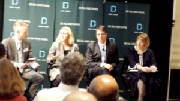Tuesday, January 30, 2018
What Turns Reporters On?
Has the focus of today's
news reporting regressed or progressed? Perhaps no one should know better than journalists. For
those who equate news with an aggregation of fact, here is an interesting commentary from a former political speech
writer turned opinion editor and columnist:
"Reporters, especially though not exclusively political
reporters, are more interested in the meaning of facts than in the facts themselves. They're concerned
with interpretation rather than accuracy, with 'narrative' rather than detail, with explaining rather than disclosing, with
who's happy or angry about a story rather than whether it's true, with what's likely to happen next week or next year rather
than with what happened yesterday." --Barton Swaim, columnist in a
Wall Street Journal "Bookshelf" review of Michael Wolff's Fire and Fury.
PS--For
more on the definition of news, see "What is news" on this web site.
-- Jeff Bogart
12:02 pm est
Saturday, September 17, 2016
12:00 pm edt
Journalists Are Becoming Ad Copywriters
Seems as though journalists are being called
on these days to work as public relations consultants and ad copywriters. That's the conclusion one can draw from a
recent Folio magazine article. Under a headline that reads "Majority of Publishers Use Their Own Editorial Staffs
to Produce Native Ads," Folio reports on results of a recent study by London-based trade association FIPP and the Copenhagen-based
Native Advertising Institute. Findings include:
"Over two-thirds of magazine publishers leverage their own editorial teams to
produce native advertisements, according to a study from FIPP and the Native Advertising Institute.
"Of 140 magazine executives surveyed around the world [in 39 countries], 68
percent report that their editorial team produces native ads, more than twice as many as the 31 percent who say they use an
in-house native advertising studio, and nearly three times as many as the 24 percent who use a separate native ad team to
produce sponsored content. Far fewer publishers make use of an external agency partner (12 percent), or an advertising agency
(six percent)."
That's not the
way it used to be, was it? Which might lead a purist to ask, What's the difference these days between journalism and
public relations, anyway?
-- Jeff Bogart
Sunday, September 11, 2016
About "Fleek"?
Have you come across the word "fleek" before?
As in "on fleek"? Saw it for the first time in today's NYT—not in the Style but in the Business Section,
of all places! Looked it up online, and came across the following article examining its derivation: https://www.visualthesaurus.com/cm/dictionary/geeking-out-on-fleek/. Check it out, because it’s a fleek of an article.
This writer, incidentally, is very good, so I’ll need
to explore some of the other posts on this site. Seems as though William Safire lives!
--
Jeff Bogart
Saturday, July 30, 2016
Word Play
Another
portmanteau word: Slurk. But what does it mean?
-- Jeff Bogart
Friday, July 29, 2016
Best ever!
When you have a great new idea, the first person you
sell on it is . . . yourself!
-- Jeff Bogart
Tuesday, May 24, 2016
Crain's Letter
My letter appeared this week in Crain's New York Business, both the print and online
editions. The response to my proposal has been positive:
I would support that...in its presentation I would also show the amount by which taxes
have increased each year.
A modest proposal.....would be interesting
for sure!
Makes sense to me...
Good idea...
Great Idea! Thanks Jeff
To read the letter, click here.
-- Jeff Bogart
Wednesday, March 2, 2016
Is Social Media Worth It?

Perhaps when used for B to C marketing, social media makes
sense. But what about for professional services firms engaged in B to B? I just received an email from a consultant
to those service firms whose offerings are built on expertise (e.g., marketing, media, advertising, management consulting).
The email pans social media for most such firms. It's appropriate, the consultant says, "for a few of
you but it’s a luxury that fits really well as the last 5% on top of more substantive marketing activities. The ROI
isn’t there, the stop/start of the activity is distracting, and it’s like running in place instead of actually
walking somewhere." Of course, ROI is not what social media marketing is all about, right? Listening, Visibility,
Perception Building and Engagement are its hallmarks, as we all no doubt recognize. Nevertheless, I wonder: Does anyone
at professional services firms have concrete evidence that social media marketing to other businesses has really worked for
his/her firm? Let me know.
-- Jeff Bogart
Monday, February 29, 2016
In Advance of the News
Just what stories will the news media be covering this
year? Editors develop annual lists that identify important stories by month and date. The lists, or datebooks,
help them with staffing logistics and enable reporters to conduct research, identify angles and write stories in advance of
the event.
Datebooks are, of course, works in
progress, with new items added as the year unfolds. Public relations executives who scan these lists can sometimes figure
out ways in which their clients or companies might play a role in the unfolding and news coverage of these events. That's
true both for internal and external communications.
Here are links to the Wall Street Journal's datebook of global events and datebook of Greater New York published online on January 4. Here (chart, left) also is a combined snapshot from those
datebooks of events occurring in March. We will soon be reading about them in the news.
-- Jeff Bogart
Friday, February 26, 2016
Compliance Chiefs Provide Anticorruption
Insights at Dow Jones Breakfast
"We don't like to
use the term 'whistle blower,'" said Nicholas Elliott, editor, WSJ Risk & Compliance Journal.

His was one of the comments I heard while attending the anticorruption
compliance breakfast held in midtown Manhattan by Dow Jones Risk & Compliance on Feb. 23.
Elliott moderated a panel of chief ethics and compliance officers from Merck &
Co., General Electric, and Bechtel. Here are some of the corporate executives' observations:
-- "Good and effective compliance is local compliance,"
not centrally imposed compliance. We invest locally in it.
-- After reducing our 65-page conduct code by two thirds, "something great happened--employees started
to read it."

- --". . .[W]hen you simplify, you force yourself to hone
in on the why and not the what."
- --
"We need our employees exercising good judgment . . . not simply following a set of rules."
-- We still have 60 pages of code. You cannot just assume that people know
the right thing to do.
--You cannot write rules
that cover every situation; but you can create the expectation of following the rules.
-- A culture of compliance is "far and away"
the most important component of an effective compliance program.
-- A sign of a strong culture of
compliance is when what you ask be done is well received.
-- A second "true sign"
of compliance effectiveness--emphasis on coming forward to report what is seen.
-- If there is quiet among employees, that is "the first important sign of trouble."
--Assess the tone about compliance not only at  the top of the company but also at the bottom among
line workers and first-line management. If it is positive there, "then you're almost home."
the top of the company but also at the bottom among
line workers and first-line management. If it is positive there, "then you're almost home."
--The biggest change in compliance in recent years is a transition from training and education to auditing and monitoring.
-- Another big change in compliance is the use of data analytics to know when to
audit.
-- Jeff Bogart
Around Town
Some recent
event photography by me, including a holiday party, reception, ballgame party, and parade:






-- Jeff Bogart
Monday, October 6, 2014
Howz That?
What about how? The answer to that question
is there is a legal battle brewing over whether "how" is trademarkable, according to a front-page story in today's The New York Times. Who would have thought that "how" would ever rise to
such importance. Why it's almost at the very end of the list journalism students are traditionally required to
memorize--who, what, when, where, how and why --implying, in other words, that its presence could be a mere afterthought.
But that is not the case, when you get right down to it, for the litigants in The Times’ story: Where one might once have minimized or dismissed the term, the modern meaning of how,
for them at least, is that it matters. Or is it that the matter with how is that it has grown to have increased
meaning? We will most likely have to wait for one or more legal minds to parse the English language to find out.
Now, how about that!
-- Jeff Bogart
Tuesday, September 16, 2014
Taking the Measure of PR
 Seeking insight into how to measure the success or failure of public relations programs? Here are some truisms from
the keynote speaker at yesterday's gathering in New York on the subject:
Seeking insight into how to measure the success or failure of public relations programs? Here are some truisms from
the keynote speaker at yesterday's gathering in New York on the subject:
1. "[The] measure of the value created by social media is qualitative, not quantitative."
2. Quarterly sales results are not
a meaningful measure of long-term relationship building.
3. Business intangibles are where a lot of PR benefit is created.
4. "Content that moves creates power"--i.e., it needs to be disseminated/distributed/shared.
5. Share of conversation can be an
indicator of sales.
6. When a
conversation has been identified as relevant, marketing managers want to know how people connect to it and how they can keep
the conversation going.
7. "Sometimes
it's not about ROI [return on investment]; it's about relevance."
The speaker was Mark W. Schaefer, a marketing consultant and Rutgers University instructor.
The event sponsored by Cision and Vocus, was part of AMEC (International Association for Measurement and Evaluation of Communication)
Measurement Week.
-- Jeff Bogart
Thursday, September 11, 2014
Financial
Media for Sale: Step Right Up!
 The sale over the last year and the recently reported shopping by Thomson Reuters of some specialty financial media (peHUB Wire
9/8/14) suggest, arguably, that their owners foresaw--and Thomson Reuters still foresees--slacking sales and lower profit
margins, as well as declining financial markets and the economy in the future. After all, if results can
only get better and not worse, why sell?
The sale over the last year and the recently reported shopping by Thomson Reuters of some specialty financial media (peHUB Wire
9/8/14) suggest, arguably, that their owners foresaw--and Thomson Reuters still foresees--slacking sales and lower profit
margins, as well as declining financial markets and the economy in the future. After all, if results can
only get better and not worse, why sell?
So let's speculate, for a moment, about how things might get worse for possible new owners of such media.
New owners will have limited options to make back their purchase price plus a profit--they can, of course, cut costs
by firing staff and by eliminating print editions. Or they can seek to hike revenue by raising the price
of their products to subscribers, by raising ad prices; by adding more product extensions such as conferences and webinars;
and by changing the substance of those products to attract a wider, more general audience. The downsides
of these strategies include degradation in product quality and declines in the existing audience and advertising bases.
 On the other hand, beauty is in the eyes of the beholder, every cloud has a silver lining, each option carries not only risk
but opportunity, and, as has been said, "The meek may inherit the earth--but not its mineral rights."
There may indeed be ways to profit from the purchase, such as by adding to the subscriber base and demographics and
content of the purchaser's already existing media properties.
On the other hand, beauty is in the eyes of the beholder, every cloud has a silver lining, each option carries not only risk
but opportunity, and, as has been said, "The meek may inherit the earth--but not its mineral rights."
There may indeed be ways to profit from the purchase, such as by adding to the subscriber base and demographics and
content of the purchaser's already existing media properties.
In that case, step right up, ladies and gentlemen.
For Thomson Reuters's media properties PeHUB ("a blog that covers PE and VC news"), Buyouts ("a bi-weekly magazine that covers news and trends in the buyouts market") and VCJ (Venture Capital Journal--"a monthly magazine that covers the venture capital business"), let the
sale process begin.
-- Jeff Bogart
Wednesday, September 10, 2014
Lessons From This Year's U.S. Open:
1) Due to upsets, the best/most exciting Grand Slam tennis matches often occur in the quarter-
and semi-finals.
2) It's time to add scoreboards for the onsite
fans so they can keep count of aces, serving speed, rally lengths, winners/errors, remaining challenges.
3) Focus TV cameras on serve speed more often than now, especially when there is a big-deal
server.
4) Why not give awards to the most entertaining player,
the fastest serving player, the most strategic player, and the first-time player deemed most likely to succeed.
5) And last but not least, to offset the advantage gained by super-serving giants whose
height and wingspans exceed 6' 5", raise the height of the net and enlarge the side of the court they occupy!
-- Jeff Bogart
Thursday, May 8, 2014
Where Mainstream Journalism Is Heading
At Columbia Journalism School's recent Alumni Weekend, media consultant Mario
Garcia delivered an excellent illustrated talk on understanding new media and how it is evolving. Even if you hate new media
(a misnomer because it is no longer new), you may want to check out where mainstream journalism is heading. You can access
the talk, which was streamed live, on YouTube at http://www.youtube.com/watch?v=aS1IPYalTt0 .
Garcia is introduced by Bill Grueskin, Columbia J-School's academic dean and former WSJ deputy managing
editor for news . Here are two slides from the talk:  and
and  Worth viewing.
Worth viewing.
--
Jeff Bogart
Tuesday, January 21, 2014
Winter Recall
I recall when I worked as a reporter for UPI in Kansas City seeing a story about
an American Indian with a dire prognostication. He warned that if America landed a man on the moon it would
change Earth's weather patterns. Looking at today's heavy snowstorm plus global warming, it seems as though he was right.
Just who was that medicine man, anyway?
--
Jeff Bogart
7:04 pm est
Tuesday, January 7, 2014
Fashion Note
Despite
near-zero outdoor temperatures and wind chill values as low as 15 below zero, I spotted only three guys who arrived wearing
sweaters, and just one more wearing a vest, under their jackets at today's ACG New York Sports M&A luncheon
at the Union League Club attended by almost 80 people. Brr!
--
Jeff Bogart
Friday, October 11, 2013
I just came across the below letter of mine published in PR Week's print edition quite some time ago in response
to an article critical of the use of public relations in politics. Given the ongoing political wars, it seemed timely:
Sir,
Congratulations on
your well written editorial on the difference between political and other forms of PR, `The epitome of the practice, or a
corruption?' (PR Week, October 10).
It's possible that marketing,
not PR is the culprit behind the problem you cite: `There was a time when politicians actually started from a set of
beliefs and tried to convince the public that those beliefs were right, rather than the other way around.'
It's a marketing tenet to find out what the consumer wants, then give it to him.
Which may be why that public is getting it right and left these days from both parties. It's a PR tenet, on the other
hand, to identify what the public knows and believes, in order to determine how best to educate it.
There seems
to be, then, at least one difference between marketing and PR. Simply put, marketing conforms; PR informs.
--
Jeff Bogart
Tuesday, October 8, 2013
Did Facebook overprice its shares?
The company's initial public offering was priced at $38 a share. So did the
company and its investment bankers flunk I-banking 101?
The substantial drop in price soon after the offering
might make you think so. But Fortune columnist and blogger Dan Primack disagrees, saying:
"as I wrote at the time, $38 was the perfect price."
For Primack's reasoning
and his view of the investment banker's role, see Facebook's IPO Was No 'Disaster'
--
Jeff Bogart





 the top of the company but also at the bottom among
line workers and first-line management. If it is positive there, "then you're almost home."
the top of the company but also at the bottom among
line workers and first-line management. If it is positive there, "then you're almost home."


 Seeking insight into how to measure the success or failure of public relations programs? Here are some truisms from
the keynote speaker at yesterday's gathering in New York on the subject:
Seeking insight into how to measure the success or failure of public relations programs? Here are some truisms from
the keynote speaker at yesterday's gathering in New York on the subject:  The sale over the last year and the recently
The sale over the last year and the recently  On the other hand, beauty is in the eyes of the beholder, every cloud has a silver lining, each option carries not only risk
but opportunity, and, as has been said, "The meek may inherit the earth--but not its mineral rights."
On the other hand, beauty is in the eyes of the beholder, every cloud has a silver lining, each option carries not only risk
but opportunity, and, as has been said, "The meek may inherit the earth--but not its mineral rights." and
and 